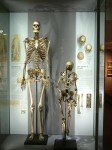Eleven Christmases ago, the British Medical Journal published an article appealing for the burial at sea of  the remains of Charles Byrne, the “Irish giant” whose skeleton has been on public display at the Hunterian Museum in London for two centuries, very, VERY much against his expressed will. The Hunterian declined, claiming that the scientific value of Charles Byrne’s bones “outweighs the benefits of carrying out Byrne’s apparent request to dispose of his remains at sea.”
the remains of Charles Byrne, the “Irish giant” whose skeleton has been on public display at the Hunterian Museum in London for two centuries, very, VERY much against his expressed will. The Hunterian declined, claiming that the scientific value of Charles Byrne’s bones “outweighs the benefits of carrying out Byrne’s apparent request to dispose of his remains at sea.”
They still think that. Charles Byrne will not be buried at sea or anywhere else, for that matter. But they have, in what strikes me as a somewhat grudging, defensive statement, agreed that he will no longer be on public display. The museum has been closed for redevelopment so visitors haven’t been able to gawk at Byrne for the past five years. When it reopens in March, Byrne’s skeleton, formerly the flagship of the museum’s anatomical specimens collection, won’t be there. From the statement:
John Hunter (1728-1793) and other anatomists and surgeons of the 18th and 19th centuries acquired many specimens in ways we would not consider ethical today and which are rightly subject to review and discussion.
These are weasel words to employ in this situation because stealing dead bodies was considered unethical back then too. Worse than that, it was considered illegal. Worse than THAT, it was considered a monstrous blasphemy because it impeded resurrection of the dead at the Last Judgment. This is in no way a case of modern sensibilities being forced onto the past. Grave-robbing was reviled far more then than it is now.
The skeleton will be retained as it is an integral part of the Hunterian Collection and will be available for bona fide research into the conditions of acromegaly and gigantism.
They have his DNA, extracted from a molar and used to map a genetic cluster of gigantism in Ireland, and that is available to researchers. They could easily 3D scan his body and make that data available to researchers all over the world in an instant. His bones are simply not necessary for any scientific research at this point, and given the cruel treatment he received at the hand of the museum’s founder, both in life and in death, I think he’s more than earned the eternal rest he wanted so badly.
 Born in the village of Littlebridge, Northern Ireland, in 1761, his extraordinary stature became apparent in early childhood. He drew crowds locally when he was still in school, and as a teenager was engaged by a promoter to tour Ireland. He moved to London around 1780 and was initially a huge success. He was presented at court; he starred in a play. When the novelty wore off and he could no longer book big events, he just stayed in his room and advertised himself in newspapers, charging half a crown admission per person to see the “Irish Giant,” billed as the tallest man in the world. (His height was reported at the time to be 8’4″, but his skeleton is 7’7″ so he was probably more like 7’10” in life.)
Born in the village of Littlebridge, Northern Ireland, in 1761, his extraordinary stature became apparent in early childhood. He drew crowds locally when he was still in school, and as a teenager was engaged by a promoter to tour Ireland. He moved to London around 1780 and was initially a huge success. He was presented at court; he starred in a play. When the novelty wore off and he could no longer book big events, he just stayed in his room and advertised himself in newspapers, charging half a crown admission per person to see the “Irish Giant,” billed as the tallest man in the world. (His height was reported at the time to be 8’4″, but his skeleton is 7’7″ so he was probably more like 7’10” in life.)
Human oddities were prized by anatomists, and giants were particularly rare. The vultures were already circling while Byrne was still alive. In addition to his increasingly poor health caused by his condition, he was also an alcoholic with tuberculosis, so his days were numbered and everyone knew it. Scottish surgeon John Hunter sent a man named Howison to Byrne’s room at Spring Gardens, London. After paying his half-crown, Howison relayed an offer from John Hunter to buy his body after he died, cash in advance, of course. Byrne was horrified and refused. Hunter dispatched Howison to return every single day so he could let him know the second Byrne died giving Hunter the chance to get the jump on the other ghouls vying for the poor man’s body.
The thought that the anatomists would get to him and dissect his body plagued Byrne. He knew he wouldn’t live long and he made arrangements to prevent him suffering this fate. He had a lead coffin built and arranged for his Irish friends to guard it and his body until it could be transported down the Thames to the Downs and sunk in the English Channel.
This information was not kept under wraps. Newspaper articles were written about the planned burial and how the resurrectionists were trying to foil Byrne’s measures. According to one London paper, “the body-snatchers, however, are determined to pursue their valuable prey even in the profoundest depth of the aquatic regions; and have therefore provided a pair of diving bells, with which they flatter themselves they shall be able to weigh hulk gigantic from its watery grave.” Another magazine noted that he’d requested burial at sea “in order that his bones might be removed far out of the reach of the chirurgical fraternity, in consequence of which the body was put on board a vessel, conveyed to the Downs and sunk in twenty fathoms of water.” If only that had been true.
What happened next is unclear. Hunter bribed either the undertaker or Byrne’s Irish bodyguards to remove him from the lead coffin, putting stones in his place. The coffin then continued on with the original plan. The body was carted away in John Hunter’s carriage.
 He never even dissected him. That very night, Hunter boiled the flesh off of Byrne’s bones so he could reassemble the body for mounting in his anatomical specimen collection. It was on the wall in his private study when Hunter commissioned artist Joshua Reynolds to paint his portrait in 1786. You can see Byrne’s feet and long shin bones in the back right. The boiled bones of Charles Byrne went on public display in 1799, six years after Hunter’s death.
He never even dissected him. That very night, Hunter boiled the flesh off of Byrne’s bones so he could reassemble the body for mounting in his anatomical specimen collection. It was on the wall in his private study when Hunter commissioned artist Joshua Reynolds to paint his portrait in 1786. You can see Byrne’s feet and long shin bones in the back right. The boiled bones of Charles Byrne went on public display in 1799, six years after Hunter’s death.
John Hunter is buried in Westminster Abbey where his tombstone describes him as “The Founder of Scientific Surgery.” Charles Byrne is in a box in museum storage. The Joshua Reynolds portrait of John Hunter will be displayed in the spot where Charles Byrne’s body was formerly exhibited.
Great commentary. I completely agree with you. Horrible.
This terrible case reminds me of Truganini. She was one of the last Tasmanian aboriginals of full descent. Before her death in 1876 she begged authorities to give her a respectful and traditional end but two years later her bones were sent to the British museum for display. It took until very recently for traditional elders to reclaim her remains. Very sad business…